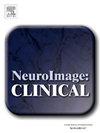Abnormal structural covariance network in major depressive disorder: Evidence from the REST-meta-MDD project
IF 3.6
2区 医学
Q2 NEUROIMAGING
引用次数: 0
Abstract
Background
Major depressive disorder (MDD) is a common mental illness associated with brain morphological abnormalities. Although extensive studies have examined gray matter volume (GMV) changes in MDD, inconsistencies persist in reported findings. In the current study, we employed source-based morphometry (SBM) and structural covariance network (SCN) analyses to a large multi-center sample from the REST-meta-MDD database, aiming to characterize robust results of structural abnormalities in MDD.
Methods
We analyzed 798 MDD patients and 974 healthy controls (HCs) from the REST-meta-MDD consortium. Voxel-based morphometry was applied to generate GMV maps. SBM was used to adaptively parcellate brain into different components, and SCN was constructed based on SBM components. Volume scores in each component and SCNs between the components were both compared between MDD and HC groups, as well as between first-episode drug-naive (FEDN) and recurrent MDD subgroups.
Results
SBM identified 20 stable components. Three components encompassing the middle temporal gyrus, middle orbitofrontal gyrus and superior frontal gyrus exhibited volumetric differences between the MDD and HC groups. Volume differences were observed in the cingulate cortex and medial frontal gyrus between the FEDN and recurrent groups. SCN analysis revealed 9 aberrant pairs in MDD vs. HCs, and 7 pairs in FEDN vs. recurrent groups. All aberrant component pairs in the SCN implicated the prefrontal cortex.
Conclusions
These findings demonstrated brain structural deficits in MDD, and highlighted the prefrontal cortex as a central hub of SCN alterations. Our findings advance the understanding of MDD’s neural mechanisms and suggest directions for diagnostic research.
重性抑郁症的异常结构协方差网络:来自REST-meta-MDD项目的证据
重度抑郁障碍(MDD)是一种常见的与脑形态异常相关的精神疾病。尽管广泛的研究已经检查了重度抑郁症中灰质体积(GMV)的变化,但报道的结果仍然不一致。在当前的研究中,我们采用基于源的形态学(SBM)和结构协方差网络(SCN)分析来自REST-meta-MDD数据库的大型多中心样本,旨在表征MDD结构异常的可靠结果。方法我们分析了来自REST-meta-MDD联盟的798名MDD患者和974名健康对照(hc)。采用基于体素的形态测量技术生成GMV地图。利用SBM自适应地将大脑分割成不同的组件,并基于SBM组件构建SCN。在MDD组和HC组之间,以及首次用药(FEDN)组和复发性MDD亚组之间,比较各组成部分的体积评分和组成部分之间的scn。结果ssbm鉴定出20种稳定成分。在MDD组和HC组中,颞中回、眶额中回和额上回三个组成部分的体积表现出差异。FEDN组和复发组在扣带皮层和额叶内侧回中观察到体积差异。SCN分析显示MDD组与hcc组有9对异常,FEDN组与复发组有7对异常。SCN中所有异常成分对都与前额皮质有关。这些发现证明了重度抑郁症的大脑结构缺陷,并强调了前额皮质是SCN改变的中心枢纽。我们的发现促进了对重度抑郁症神经机制的理解,并为诊断研究提供了方向。
本文章由计算机程序翻译,如有差异,请以英文原文为准。
求助全文
约1分钟内获得全文
求助全文
来源期刊

Neuroimage-Clinical
NEUROIMAGING-
CiteScore
7.50
自引率
4.80%
发文量
368
审稿时长
52 days
期刊介绍:
NeuroImage: Clinical, a journal of diseases, disorders and syndromes involving the Nervous System, provides a vehicle for communicating important advances in the study of abnormal structure-function relationships of the human nervous system based on imaging.
The focus of NeuroImage: Clinical is on defining changes to the brain associated with primary neurologic and psychiatric diseases and disorders of the nervous system as well as behavioral syndromes and developmental conditions. The main criterion for judging papers is the extent of scientific advancement in the understanding of the pathophysiologic mechanisms of diseases and disorders, in identification of functional models that link clinical signs and symptoms with brain function and in the creation of image based tools applicable to a broad range of clinical needs including diagnosis, monitoring and tracking of illness, predicting therapeutic response and development of new treatments. Papers dealing with structure and function in animal models will also be considered if they reveal mechanisms that can be readily translated to human conditions.
 求助内容:
求助内容: 应助结果提醒方式:
应助结果提醒方式:


